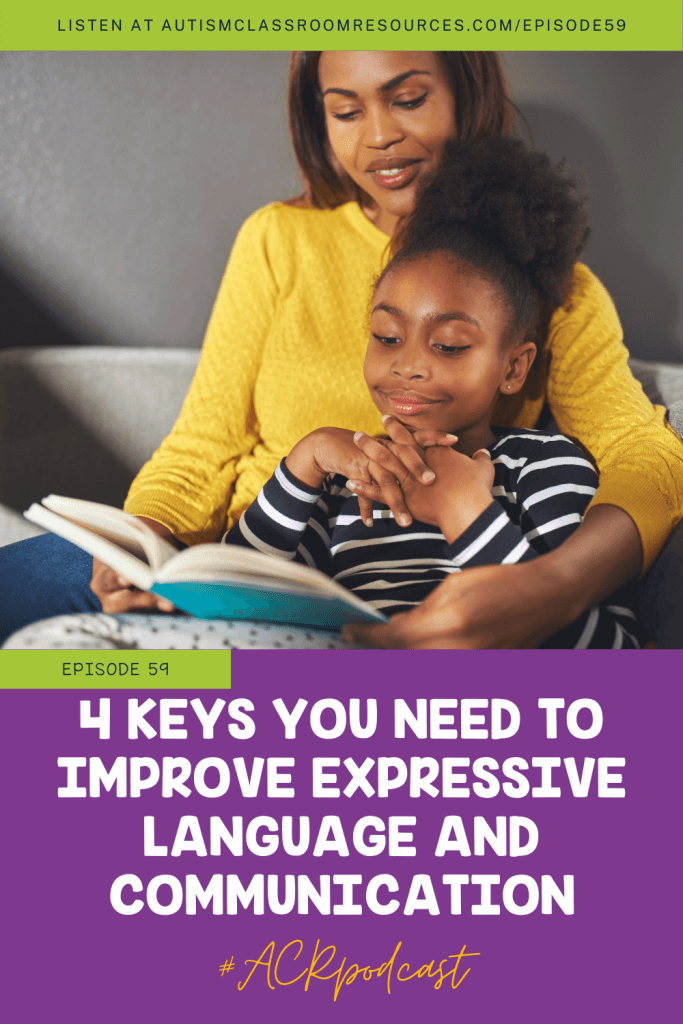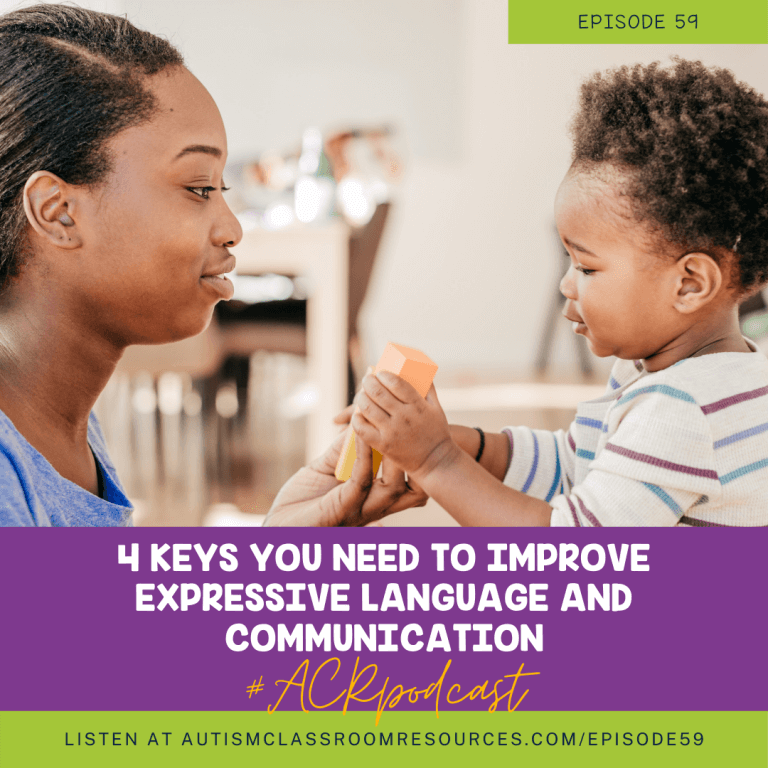Let’s face it, we all want our students to talk. We know we need to improve their expressive language to do that. But expressive language is more complex than just talking. And in fact there are several key elements that we need to address in our instruction to help our students communicate effectively.
Highlights for Episode 59
Today I’m going to talk about the 4 keys you need to address in your instruction for expressive language. It’s important to remember that expanding expressive language goes beyond just getting longer sentences or adding vocabulary, particularly for students with ASD. In order to improve communication, we have to focus on how the expressive language is used. That includes increasing the reasons or functions of the use of language, expanding the situations in which the student uses expressive language, initiating and independence of language, and finally expanding the types of vocabulary.
1. Focus on Initiation
One of the biggest struggles for students with ASD is initiating communication. This is true whether they are verbal or nonverbal. It’s always important to remember that autism is more than a delay in language. Students with ASD have difficulty knowing how to use language effectively to get basic needs or social needs met. Consequently, it’s important to make sure that we have developed strategies to encourage initiation of communication. Being able to communicate something only when someone asks you a question is not effective communication. In order to be independent, individuals need to be able to understand that communication means getting someone’s attention, delivering a message, and persisting until that message is delivered.
Initiation is a door opener. When a student can initiate, he can learn more independently. This is especially true in communication. When a student initiates, he can go up to someone and start an interaction. That’s significantly different than a student who has to wait for interactions (and learning) to come to him.
Initiation for Nonverbal Students
One of the things that I love about the Picture Exchange Communication System (PECS) is that it specifically teaches the process of communication with an emphasis on initiation. I put a post in the show notes that talks more about the elements of PECS. And it specifically addresses why it is worth consideration for students who need augmentative communication. In the meantime it’s important to understand that PECS refers to the SYSTEM of instruction NOT the pictures.
Initiation for Verbal Students
For students who are verbal, we still see them struggle with initiating interactions and communication with others. To help with that, scripts are a terrific way to help students initiate delivering messages and a variety of other types of communication. I have talked about these extensively HERE. They are also a great way to expand language to go beyond requesting to commenting and conversation.
I show how to use some sentence strips in this video to help with initiation and increasing functions.
2. Integrate Expressive Language and Communication Instruction EVERYWHERE
In order to get students to use their communication throughout their day, we need to teach them and practice expressive language throughout their day. This means making sure that we have planned out multiple communication opportunities in every activity of their day.
For students who are nonverbal or who are still working on communicating effectively, it means making sure that their communication supports are available everywhere in the room. It also means that communication supports shouldn’t be offered only when the teacher is directing communication. In order to increase initiation, we have to allow them access to communication supports like visual supports wherever they are. That may mean creating communication boards to be available anywhere in the room. It may also mean integrating speech generating devices into activities and routines.
Check out how you can use it in this Tuesday Quick Tip Video
Try This Exercise to Improve Expressive Vocabulary
When I do professional development, I ask participants do the following. Sit and think about your classroom and choose 3 activities to start. For each activity, write down 3 ways you can create communication opportunities. For instance, during an art activity the student could:
- request colors of paint
- comment on a friend’s art project
- describe their own project
Obviously he could request more than colors. But that gives me 3 functions of language that the student can practice. Or it might be one function that each student can practice within the activity. Do that for every activity of the day, and you are embedding tons of expressive language into the student’s learning.
3. Expand the Functions of Expressive Language
Communication is about more than just talking. We all use expressive language for a variety of reason. It’s about making requests for desired items and things that aren’t the big reinforcers but that we need. Students need to comment to other people about what they see or hear. They need to describe things using different adjectives like color and size. And they hold conversations.
In addition, it’s important that we don’t get stuck on just increasing how many words a student says. Or how many requests he makes during a day. Instead, we need to be focusing on HOW he is using his language. Is he asking questions? Answering questions? Describing things? I’ll put a link in the show notes to a whole post where I talk about communicative functions with more detail.
We may start with basic requesting, since it has the most powerful reinforcers. However, we have to make sure we move on to other functions in order for language to be meaningful in someone’s life.
This Tuesday Quick Tip has ways you can use scripts to increase functions.
4. Expanding Types of Expressive Language and Vocabulary
And finally, we have to teach students expressive vocabulary. However, we also have to teach them how to USE that vocabulary. It’s not enough to just teach students to name colors and assume that they are do more than name colors. For instance, they likely won’t use those colors to describe something that they see without explicit instruction. So, for many if not most students with autism, we have to teach them how to use the vocabulary in a meaningful way.
There are a variety of ways that we can do that. For instance, we might put their favorite treats in colored boxes so that they have to describe the box they want that holds the treat. This means that the color has meaning by making the use of it more reinforcing. It talk more about doing this in this Tuesday Quick Tip video.






